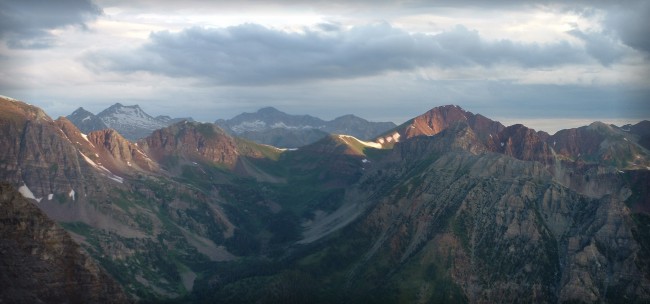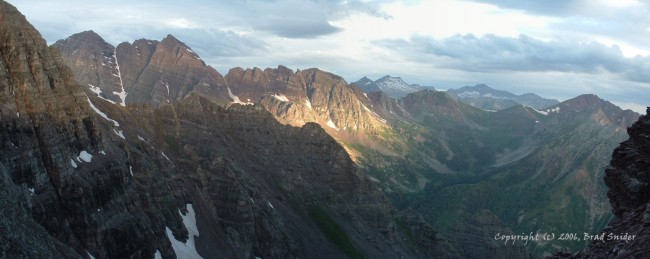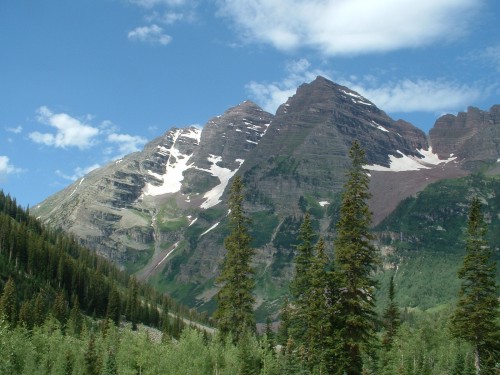Pyramid Peak: 14,018 feet
Round-trip distance: 7 miles
Elevation gain: 4,500
feet
With a forecasted 60% chance of thunderstorms, I was not going to risk a late start on Pyramid Peak. I was on the trail by 3:45, and made easy progress toward Crater Lake. I found the unmarked turnoff for Pyramid Peak by the light of my headlamp without a problem, and mentally verified two things right off the bat: 1. This trail is steep, as promised, and 2. Colorado Fourteeners Initiative has really done a lot of work, making most of the trail very accommodating to the environment and climbers (aside from the inevitable steepness, of course).

Elk Range Scenery

From the top of the steep switchbacks, which ended at timberline, I found a welcome snow slope leading the rest of the way up to the amphitheater. As daylight began to take over, I was awed immediately by the impressive bulk of Pyramid Peak, which lay dead ahead. Having to give up the snow slope at the top, I talus-hopped my way across to the other side of the moraine. There, I took a break to put on my helmet and checked the time: 6 o’clock.
The slope before me looked scary at first glance, but as I followed the climber’s trail upward, it turned out to be not bad at all. It was steep, for sure, but I was getting used to that. Meanwhile, the morning light illuminated the Elk Range in a spotty fashion, as clouds were filtering in quickly. The scenery was beautiful, but I was nervous about the weather.

The mountain
I made great time getting to the first saddle, and from there I had an intimidating view of what lay ahead. After an easy hike to the next notch in the ridge, it appeared I was about to begin my climbing in earnest. However, the first section of ridge, which Roach describes in his guidebook as a class 4 crux, was easily negotiated by way of a cairned class 2+ trail following ledges.
The trail soon left the ridge and contoured toward a feature I have seen numerous times in photographs of Pyramid Peak: the “cliff traverse” ledge. This narrow ledge resides along a cliff that drops off forty feet below. As I expected, it was not nearly as difficult or daunting as the pictures make it look, but it was fun. The loose gravel and mud just before the ledge were actually a bit more unnerving than the ledge itself.
From there, I followed more ledges upward and across to the infamous “Green Couloir,” so named because the rock is, well, green. To this point, I was beginning to wonder if there was going to be any scrambling or climbing at all, because so far all I had done was hike along somewhat-exposed ledges.

Pyramid from the amphitheater
There the scrambling did begin, but I never really experienced any sustained class 4 in this section. There were some class 4 moves, and I was able to stay a little off-route for some more class 4 climbing. As it turns out, I never got back on the correct route after leaving the Green Couloir, because I never made it to the ridge. Instead, I scrambled up exposed ledges and climbed some class 4 areas on the east face. All in all, this face was not bad. The climbing was not as hard as I expected, but the two factors of loose rock and exposure were there as promised. Neither bothered me, as the loose rock was mostly avoidable by taking my time and finding good holds. I did not find the exposure too daunting either, probably because I have been getting more experience dealing with it in the past few years.
This climb was a real delight. However, even as I was enjoying the scrambling to the summit, I was becoming more concerned about the weather. A couple times, raindrops fell briefly, barely wetting the rock, and then went away. Clouds were blanketing most of the sky, and I saw some virga in the distance.

Looking down
The climbing ended abruptly as the terrain flattened out to the summit. I arrived at eight o’clock, thrilled to have made it to what Roach calls “One of Colorado’s most rewarding fourteener summits.” At this point, the sky looked stable enough, but I know from experience how quickly that can change up there. I stayed on the summit for about half an hour, taking pictures most of that time.
The descent turned out to be easier than I ever imagined. I found the correct trail to the ridge proper this time, and found it to be mostly class 2 or class 3. Only an occasional class 4 move was required. Also, there were cairns everywhere in this area.
I passed a solo climber in this upper section, who was somehow coming from a different direction (north). Below him, two more climbers were coming up the standard route, just topping out at the Green Couloir. After exchanging greetings with them, I joined my ascent route at this point, then made my way slowly to the base of the green rock. From there I followed the fun ledges back to the 13,000-foot saddle.
The weather still could not seem to make up its mind. As one of the passing climbers noted, “How about this weather? It seems stably unstable.” In fact, it seemed darker and more foreboding of rain at this point, but by the time I was back in the bottom of the amphitheater, I saw sunshine and blue skies.

Climbers high on Pyramid Peak
It was downright hot by the time I reached the Crater Lake Trail. Mosquitos and flies would not leave me alone, and though I’m sure I lowered their population by about one hundred, I get the feeling I didn’t even make a dent. The trail here was crowded with people too, as I expected. At one point, when I stepped into the grass to let someone pass by, a snake slithered between my legs. I don’t know what kind it was, but I did not stick around to find out.

Maroon Bells

Even though everyone has already seen it in pictures, the world-renowned view of the Maroon Bells from Maroon Lake is definitely worth seeing in person. The scenery had been top-notch all day, and the climb was a fun one too! I made it back to my jeep at 11:30, wondering if I really wanted to leave this little piece of paradise so soon.

Pyramid Peak Paradise
Some notes on Pyramid Peak: While I downplayed many of the difficulties of this mountain, it is not a climb to be taken lightly. Pyramid Peak is a dangerous mountain! Those who like to stick to hiking and do not deal well with exposure should not attempt this mountain. There is plenty of loose rock and exposure which one should be experienced with ahead of time. Remember: loose rock is not only dangerous for the climber; it is also very dangerous for climbers below. Lastly, this mountain is steep! Be ready for a good workout, take lots of water, and don’t forget your helmet!